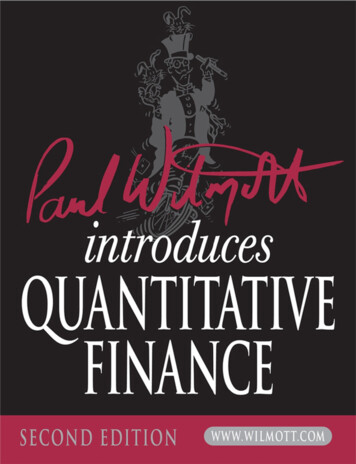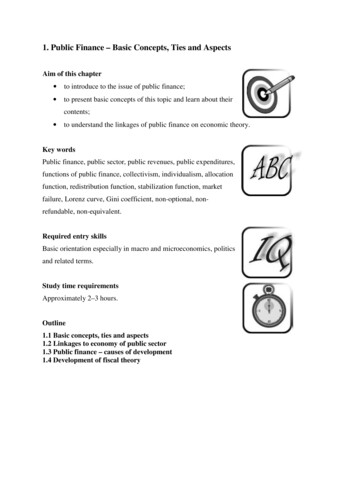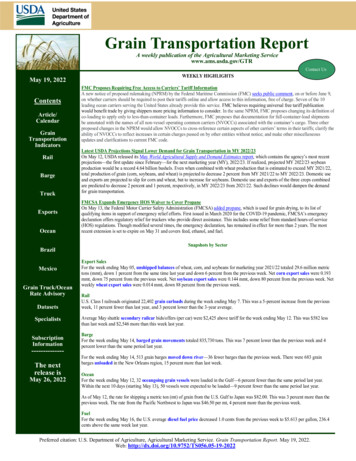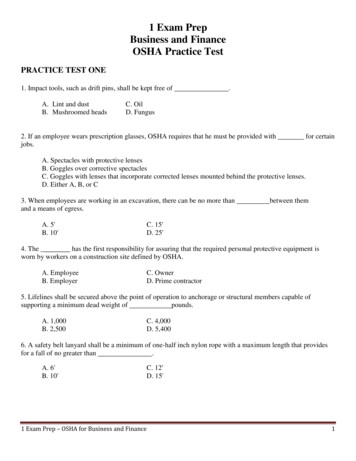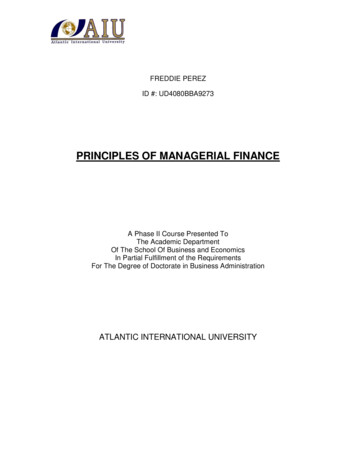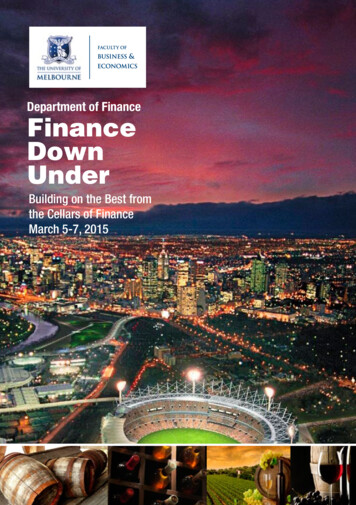
Transcription
Department of FinanceFinanceDownUnderBuilding on the Best fromthe Cellars of FinanceMarch 5-7, 2015
Department of FinanceFinanceDownUnderBuilding on the Best fromthe Cellars of FinanceMarch 5-7, 2015Organised byDepartment of FinanceFaculty of Business and EconomicsThe University of Melbourne
Welcome to FinanceDown Under (FDU) 2015The Department of Finance in the Faculty of Business and Economics at the University ofMelbourne welcomes everyone to its annual Finance Down Under conference.Submissions again reached record levels in both quantity and quality this year, and we selected only 20papers from among more than 250 submissions. These 20 papers from all areas in finance (CorporateFinance, Asset Pricing, Investments, and Market Microstructure) received high ratings from the157-member program committee, and we have a nice group of academics who will provide discussionson the accepted papers.Our unique format includes a special symposium built around ‘vintage’ work in finance that has withstoodthe test of time and continued to inspire current research. This year, FDU will celebrate the 25 years ofresearch influenced by the 1990 publication of three classic papers by Andy Lo and A. Craig MacKinlay:“When are contrarian profits due to stock market overreaction?”; “Data-snooping biases in tests offinancial asset pricing models”; and “An econometric analysis of nonsynchronous trading”. We arehonoured to have Professor A. Craig MacKinlay as a keynote speaker, as well as keynote presentationsby Professors Maureen O’Hara, Lubos Pastor and Allan Timmermann. We have also selected two papersfor Saturday’s special session in honour of Lo and MacKinlay’s classic papers.Finance Down Under 2015 Building on the Best from the Cellars of Finance 1
FINANCE DOWN UNDER 2015:Building on the Best from the Cellars of FinancePROGRAM SUMMARYThursday, March 5, 2015 (Melbourne Zoo)5:00 pm – 7:00 pmWine Reception (Rainforest Room)Welcome Speech: John Handley, University of MelbourneKeynote Speech: Maureen O’Hara, Cornell UniversityFriday, March 6, 2015 (Melbourne Cricket Ground)9:30 am – 10:00 amRegistration and Morning Coffee (Registration Desk)10:00 am – 11:15 amParallel Sessions I (Jack Ryder Rooms and Premiership Club Room)11:15 am – 12:00 pmKeynote Speech: A. Craig MacKinlay, University of Pennsylvania12:00 pm – 1:30 pmLunch (Premiership Club Room)1:30 pm – 2:45 pmParallel Sessions II (Jack Ryder Rooms and Premiership Club Room)2:45 pm – 3:15 pmAfternoon Tea3:15 pm – 4:30 pmParallel Sessions III (Jack Ryder Rooms and Premiership Club Room)4:45 pm – 5:30 pmMCG Guided Tour5:45 pm – 7:45 pmWine Reception (Premiership Club Room)Keynote Speech: Allan Timmermann, University of California San DiegoSaturday, March 7, 2015 (The Spot Building: Copland Theatre, Level B1)9:00 am – 10:00 amCoffee and tea served10:00 am – 11:15 amSpecial Session11:15 am – 12:00 pmKeynote Speech: Lubos Pastor, University of Chicago12:00 pm – 1:00 pmLunch (Dean’s Boardroom, Level 12, The Spot Building)1:00 pm – 10:00 pmFood and Wine Experience (Yarra Valley)Best Paper Award and Announcement2 Finance Down Under 2015 Building on the Best from the Cellars of Finance
ParallelSessions IMarch 6,10:00 am –11:15 amParallelSessions IIMarch 6,1:30 pm –2:45 pmParallelSessions IIIMarch 6,3:15 pm –4:30 pmPremiership Club RoomJack Ryder Room 1Jack Ryder Room 2Theoretical Asset Pricing inthe Presence of Diverse,Disparate, DivergentDecision MakersOverinvestment,Underinvestment, Just RightInvestmentFinancial Decision Making:Without Gambling, I WouldNot Exist – Hunter S.ThompsonValue or Growth? Pricing ofIdiosyncratic Cash-Flow Riskwith Heterogeneous BeliefsRetail Traders and theCompetitive Allocation ofAttentionEmpirical Asset Pricing withK Factors: 1 K 3, K is anIntegerDoes Short Selling DisciplineOverinvestment?The Impact of CovenantViolations on CorporateInvestment in R&DTheoretical CorporateFinance: The Short and theLong Run of ItGrowth Expectations,Dividend Yields, and FutureStock ReturnsIs Market Timing Good forShareholders?Linking Cross-Sectional andAggregate Expected ReturnsCorporate Policies withTemporary and PermanentShocksFunds Finishing FirstEmpirical Corporate Finance:The Long and the Short Runof ItMutual Fund Competition,Managerial Skill, and AlphaPersistenceManagerial Myopia and DebtMaturityThe Freedom of InformationAct and the Race TowardsInformation AcquisitionDo Long-Term InvestorsImprove Corporate DecisionMaking?Fooled By Randomness?Financial Decision-MakingUnder Model UncertaintyWhen Saving is GamblingContaining ContagionCounterparty Risk and theEstablishment of the NewYork Stock ExchangeClearinghouseTracing Out Capital Flows:How Financially IntegratedBanks Respond to NaturalDisastersMarket MicrostructureHigh Frequency Trading andthe 2008 Short Sale BanShades of Darkness: APecking Order of TradingVenuesSpecial Session: Overreacting to Nonsynchronous Data-snooping(The Spot, Basement Theatre)March 7,10:00 am –11:15 amIs Aggregate Idiosyncratic Risk Priced? Follow the Bid-Ask BounceAsset Pricing with Index Investing4 2015 Building on the Best from the Cellars of Finance 3Finance Down Under
PROGRAM DETAILSFRIDAY, March 6, 2015, 10:00 am – 11:15 amTheoretical Asset Pricing in the Presence of Diverse, Disparate, Divergent Decision Makers – PremiershipClub RoomSession Chair: Andrea Lu, University of MelbourneValue or Growth? Pricing of Idiosyncratic Cash-Flow Risk with Heterogeneous BeliefsMichael F. Gallmeyer, University of VirginiaHogyu Jhang, Georgia Institute of TechnologyHwagyun Kim, Texas A&M UniversityRetail Traders and the Competitive Allocation of AttentionShaun W. Davies, University of Colorado, BoulderDiscussants:Qi Zeng, University of MelbourneFilippo Massari, University of New South WalesOverinvestment, Underinvestment, Just Right Investment – Jack Ryder Room 1Session Chair: Sturla Fjesme, University of MelbourneDoes Short Selling Discipline Overinvestment?Eric C. Chang, University of Hong KongTse-Chun Lin, University of Hong KongXiaorong Ma, University of Hong KongThe Impact of Covenant Violations on Corporate Investment in R&DSudheer Chava, Georgia Institute of TechnologyVikram K. Nanda, Rutgers Business SchoolSteven Chong Xiao, Rutgers Business SchoolDiscussants:Garry Twite, University of MelbourneJordan Neyland, University of MelbourneFinancial Decision Making: Without Gambling, I Would Not Exist – Hunter S. Thompson – Jack RyderRoom 2Session Chair: André Gygax, University of MelbourneFooled By Randomness? Financial Decision-Making Under Model UncertaintyElise Payzan-LeNestour, University of New South WalesWhen Saving is GamblingJ. Anthony Cookson, University of Colorado, BoulderDiscussants:Joshua Shemesh, University of MelbourneCarsten Murawski, University of Melbourne54 Finance Down Under 2015 Building on the Best from the Cellars of Finance
FRIDAY, March 6, 2015, 1:30 pm – 2:45 pmEmpirical Asset Pricing with K Factors: 1 K 3, K is an Integer – Premiership Club RoomSession Chair: Joachim Inkmann, University of MelbourneGrowth Expectations, Dividend Yields, and Future Stock ReturnsZhi Da, University of Notre DameRavi Jagannathan, Northwestern UniversityJianfeng Shen, University of New South WalesLinking Cross-Sectional and Aggregate Expected ReturnsSerhiy Kozak, University of MichiganShrihari Santosh, University of MarylandDiscussants:Federico Nardari, University of MelbourneAntonio Gargano, University of MelbourneTheoretical Corporate Finance: The Short and the Long Run of It – Jack Ryder Room 1Session Chair: Ali Akyol, University of MelbourneIs Market Timing Good for Shareholders?Ilona Babenko, Arizona State UniversityYuri Tserlukevich, Arizona State UniversityPengcheng Wan, Arizona State UniversityCorporate Policies with Temporary and Permanent ShocksJean-Paul Decamps, Toulouse School of EconomicsSebastian Gryglewicz, Erasmus UniversityErwan Morellec, Swiss Finance InstituteStephane Villeneuve, Toulouse School of EconomicsDiscussants:Neal Galpin, University of MelbourneHae Won (Henny) Jung, University of MelbourneContaining Contagion – Jack Ryder Room 2Session Chair: Vidhan Goyal, HKUSTCounterparty Risk and the Establishment of the New York Stock Exchange ClearinghouseAsaf Bernstein, Massachusetts Institute of TechnologyEric N. Hughson, Claremont McKenna CollegeMarc D. Weidenmier, Claremont McKenna CollegeTracing Out Capital Flows: How Financially Integrated Banks Respond to Natural DisastersKristle R. Cortés, Federal Reserve Bank of ClevelandPhilip E. Strahan, Boston CollegeDiscussants:Spencer Martin, University of MelbourneLei Zhang, Nanyang Technological University6Finance Down Under 2015 Building on the Best from the Cellars of Finance 5
FRIDAY, March 6, 2015, 3:15 pm – 4:30 pmFunds Finishing First – Premiership Club RoomSession Chair: Allaudeen Hameed, National University of SingaporeMutual Fund Competition, Managerial Skill, and Alpha PersistenceGerard Hoberg, University of MarylandNitin Kumar, Indian School of BusinessNagpurnanand R. Prabhala, University of MarylandThe Freedom of Information Act and the Race Towards Information AcquisitionAntonio Gargano, University of MelbourneAlberto G. Rossi, University of MarylandRuss R. Wermers, University of MarylandDiscussants:Juan Sotes-Paladino, University of MelbourneOliver Boguth, Arizona State UniversityEmpirical Corporate Finance: The Long and the Short Run of It – Jack Ryder Room 1Session Chair: Ning Gong, University of MelbourneManagerial Myopia and Debt MaturityIndraneel Chakraborty, Southern Methodist UniversityAndrew MacKinlay, Southern Methodist UniversityWilliam F. Maxwell, Southern Methodist UniversityDo Long-Term Investors Improve Corporate Decision Making?Jarrad Harford, University of WashingtonAmbrus Kecskes, York UniversitySattar Mansi, Virginia TechDiscussants:Stefan Petry, University of MelbourneJeffrey Harris, American UniversityMarket Microstructure – Jack Ryder Room 2Session Chair: Carole Comerton-Forde, University of MelbourneHigh Frequency Trading and the 2008 Short Sale BanJohnathan Brogaard, University of WashingtonTerrence Hendershott, University of California - BerkeleyRyan Riordan, Queen’s UniversityShades of Darkness: A Pecking Order of Trading VenuesAlbert J. Menkveld, VU University AmsterdamBart Z. Yueshen, INSEADHaoxiang Zhu, Massachusetts Institute of TechnologyDiscussants:Bryan Lim, University of MelbourneZhuo Zhong, University of Melbourne76 Finance Down Under 2015 Building on the Best from the Cellars of Finance
SATURDAY, March 7, 2015, 10:00 am – 11:15 amSpecial Session: Overreacting to Nonsynchronous Data-snooping – The Spot, Copland TheatreSession Chair: Burton Hollifield, Carnegie Mellon UniversityIs Aggregate Idiosyncratic Risk Priced? Follow the Bid-Ask BounceDavid A. Lesmond, Tulane UniversityYihua Zhao, Tulane UniversityAsset Pricing with Index InvestingGeorgy Chabakauri, London School of Economics and Political ScienceOleg Rytchkov, Temple UniversityDiscussants:Thijs van der Heijden, University of MelbourneVincent Grégoire, University of Melbourne8Finance Down Under 2015 Building on the Best from the Cellars of Finance 7
BIOGRAPHY OF KEYNOTE SPEAKERSA. Craig MacKinlayJoseph P. Wargrove Professor of Finance, Wharton Business School, University of Pennsylvania.A former member of the Board of Directors of the American Finance Associationand the NASD Economic Advisory Board, Craig's research interests includeempirical implementation and validation of asset pricing models, measuringinvestment performance, pricing of futures contracts, microstructure offinancial markets, assessment of credit risk, and statistical methods in finance.In addition to teaching, he is also a Research Associate of the National Bureau of Economic Research.Craig is the co-author of two books, the Econometrics of Financial Markets and A Non-Random WalkDown Wall Maureen O’HaraRobert W. Purcell Professor of Finance, Johnson Graduate School of Management, CornellUniversityMaureen O’Hara is the Robert W. Purcell Professor of Finance at the JohnsonGraduate School of Management, Cornell University. She holds degrees fromthe University of Illinois (B.S. Economics), and Northwestern University (M.S.Economics and Ph.D. Finance), and Honorary Doctorates from FacultésUniversitaires Catholiques à Mons (FUCAM), Belgium and Universität Bern,Switzerland.Professor O'Hara's research focuses on issues in market microstructure, and she is the author ofnumerous journal articles as well as the book Market Microstructure Theory (Blackwell: 1995). Her mostrecent research looks at the role of toxicity in affecting liquidity in high frequency markets. Dr. O'Haraalso publishes widely on a broad range of topics including banking and financial intermediaries, law andfinance, and experimental economics. Professor O’Hara has served as President of the American FinanceAssociation, the Western Finance Association, the Financial Management Association, the Society forFinancial Studies and the International Atlantic Economic Society. She was formerly the Executive Editorof the Review of Financial Studies. Professor O’Hara is Chairman of the Board of Directors of InvestmentTechnology Group, Inc (ITG), a global agency brokerage firm, and she serves on the Board of Directors ofNewStar Financial, a commercial finance company, where she is on the audit and governancecommittees. She also serves on the Board of Trustees of Teachers Insurance and Annuity Association(TIAA-CREF). She is a member of the CFTC-SEC Emerging Regulatory Issues Task Force (the “flash crash”committee), the Global Advisory Board of the Securities Exchange Board of India (SEBI), and theAdvisory Board of the Office of Financial Research, U.S. Treasury. She has consulted for a number ofcompanies and organizations, including Microsoft, Merrill Lynch, Credit Suisse, the New York StockExchange, Bristol-Meyers Squibb, and the World Federation of And-Research/Profile/id/mo1998 Finance Down Under 2015 Building on the Best from the Cellars of Finance
Lubos PastorLubos Pastor is Charles is Charles P. McQuaid Professor of Finance at theUniversity of Chicago Booth School of Business. He is also co-director of the FamaMiller Center for Research in Finance, Vice President of the Western FinanceAssociation, member of the CRSP Indexes Advisory Council, Research Associate atthe National Bureau of Economic Research, and Research Fellow at the Centre forEconomic Policy and Research. In addition, he is an Associate Editor of the Journalof Finance and Journal of Financial Economics, and a former Associate Editor of theReview of Financial Studies.Professor Pastor’s research focuses mostly on financial markets and asset management. He has writtenon a broad range of topics such as liquidity risk, political uncertainty, stock price bubbles, stock volatility,return predictability, technological revolutions, portfolio choice, performance evaluation, returns to scalein active management, indexing, and IPOs. He has analyzed various effects of parameter uncertainty andlearning in finance. His articles have appeared in the American Economic Review, Journal of Finance,Journal of Financial Economics, Journal of Political Economy, Review of Financial Studies, as well asnonacademic outlets such as Bloomberg and the Financial Times. His research has been awardednumerous prizes, such as two Smith Breeden Prizes, two Fama/DFA Prizes, Whitebox Advisors SelectedResearch Prize, Goldman Sachs Asset Management Prize, Barclays Global Investors Prize, RothschildCaesarea Center Best Paper Award, two Geewax, Terker & Co. Prizes, Marshall Blume Prize, the NASDAQAward, and the Q Group Award.Professor Pastor has been teaching at Chicago Booth since 1999 when he obtained a Ph.D. in financefrom the Wharton School at the University of Pennsylvania. He has received the McKinsey Award forExcellence in Teaching as well as two Faculty Excellence Awards at Chicago Booth. In his student years,Professor Pastor won awards in chess and mathematics, mainly in his native Slovakia. In his spare time, heenjoys sports, reading, and spending time with his ry/p/lubos-pastorAllan TimmermannAtkinson/Epstein Endowed Chair, Professor of Finance, Rady School of Management, University ofCalifornia San DiegoTimmermann uses a mix of theory, data and econometric techniques tounderstand the behavior of prices and expectations in financial markets.His objective is to understand what determines the movement of security pricesand to use this in managing risk, forming portfolios and forecasting future pricemovements. He has also studied mutual fund and pension fund performance.Timmermann has developed new methods in areas such as forecasting under structural breaks, forecastcombinations and evaluation of predictive skills. He serves as an associate editor on leading journals infinancial economics and econometrics. Timmermann earned his Ph.D. from the University of immermann/10Finance Down Under 2015 Building on the Best from the Cellars of Finance 9
ABSTRACTSTheoretical Asset Pricing in the Presence of Diverse, Disparate, Divergent DecisionMakersValue or Growth? Pricing of Idiosyncratic Cash-Flow Risk with Heterogeneous BeliefsMichael F. Gallmeyer, Hogyu Jhang and Hwagyun KimWe study a continuous-time pure exchange economy where idiosyncratic cash flow risks are priced viainvestors' heterogeneous beliefs. Investors perceive idiosyncratic cash flow risks differently throughheterogeneous subjective mean growth rates on a firm's cash flow. This impacts equilibrium quantities. Ourmodel shows that idiosyncratic cash flow shocks priced through belief differences can explain crosssectional variations in stock returns and cash flows. Quantitative results show that a value premium arises,as value stocks have higher idiosyncratic cash-flow volatilities, lower average cash flows, and higher beliefdifferences, which is empirically supported. A growth premium prevails without belief differences.Retail Traders and the Competitive Allocation of AttentionShaun W. DaviesI consider a rational expectations framework in which attention constrained individuals compete againsteach other and institutions. The model reconciles a set of empirical facts that cannot be simultaneouslyexplained by standard theories: retail trader portfolios are highly correlated, retail traders tend to followsome stocks and ignore others, and aggregate trades from retail traders are profitable over short horizonsand predict future returns (even controlling for past returns or past volume). Additionally, the equilibriumherding behavior of individuals suggests that their actions are not subsumed by institutions. Instead theherd competes directly against institutions. The analysis also yields novel predictions regarding portfoliocomposition and turnover.Overinvestment, Underinvestment, Just Right InvestmentDoes Short Selling Discipline Overinvestment?Eric C. Chang, Tse-Chun Lin and Xiaorong MaWe explore the disciplining effect of short selling on overinvestment. Firms with more stock lending supplyhave higher abnormal announcement stock returns of acquiring firms, lower subsequent abnormal capitalinvestments, and longer spells between large investments, and higher subsequent Tobin’s Q and ROA.Alleviating the endogeneity concern, our multivariate difference-in-difference analysis shows that thisdisciplinary force of lending supply is more effective for firms in the Regulation SHO-PILOT Program. Weidentify two mechanisms through which short selling disciplines managers: managers’ wealth-performancesensitivity and likelihood of hostile takeovers. Additionally, the disciplinary force only exists for nonfinancial-constrained firms and non all-cash M&A deals.The Impact of Covenant Violations on Corporate Investment in R&DSudheer Chava, Vikram K. Nanda and Steven Chong XiaoUsing regression discontinuity design, we show that corporate investment in R&D declines sharplyfollowing a financial covenant violation, wherein creditors can use the threat of accelerating the loan toinfluence changes in firm policies. The reduction in R&D is more severe in firms with low R&D efficiency i.e.,when firm R&D is less productive in terms of ROA and results in fewer patents and citations. Consequently,despite a decrease in R&D, covenant-violating firms do not suffer a drop in innovative output (patents andcitations-to-patents). These results highlight that lenders are judicious in exercising their control rights aftercovenant violations and suggest that bank financing can be a viable source of financing for innovative firms.1110 Finance Down Under 2015 Building on the Best from the Cellars of Finance
Financial Decision Making: Without Gambling, I Would Not ExistFooled By Randomness? Financial Decision-Making Under Model UncertaintyElise Payzan-LeNestourTail risk is pervasive in financial markets. Overlooking it often leads to blow-ups. Here I consider assets thatyield steady streams of good payoffs but eventually inflict a major loss, leading the investor to blow up.Learning about those assets’ risk/reward profiles is crucial yet challenging. When asked to perform astylized version of the task, participants managed to learn in a Bayesian way. However, many still chose toinvest in these assets, apparently owing to an overwhelming desire to pick pennies. These findings mayhelp flesh out key psychological forces at stake during financial manias.When Saving is GamblingJ. Anthony CooksonThis paper investigates whether financial gambles substitute for casino gambling using the introduction oflottery-linked savings accounts in Nebraska as a natural experiment. Using proprietary data on casino cashwithdrawals, the introduction of savings lotteries induces consumers in affected regions to reduce casinogambling by half relative to unaffected regions. The estimated effect is stronger if savings lotteries andcasino gambling have similar attributes, consistent with the interpretation that the effect reflectssubstitution across gambling products. Examining the substitution pattern more deeply, I find savingslotteries appeal most to high dollar-value gamblers with better financial habits. These findings suggests thatsavings lotteries can be an effective tool to improve savings rates by appealing to gambling preferences,but the introduction of savings lotteries is not merely a substitute for financial education. Indeed, theimpact of savings lotteries on casino gambling would be greater if consumers have better ex ante financialhabits.Empirical Asset Pricing with K Factors: 1 K 3, K is an IntegerGrowth Expectations, Dividend Yields, and Future Stock ReturnsZhi Da, Ravi Jagannathan and Jianfeng ShenAccording to the dynamic version of the Gordon growth model, the long-run expected return on stocks,stock yield, is the sum of the dividend yield on stocks plus some weighted average of expected futuregrowth rates in dividends. We construct a measure of stock yield as a model-imposed affine combinationof dividend yield and an expected dividend growth proxy measured from sell-side analysts' near-termearnings forecasts. Stock yield predicts US stock index returns well, with an out-of-sample R-squared that isconsistently above 2% at monthly frequency over our sample period. When both dividend yield andexpected dividend growth are used as explanatory variables in a multivariate regression without anycoefficient restriction to predict future stock returns, the in-sample R-squared is almost the same as thatfor stock yield, but the out-of-sample R-squared is only about half of that for stock yield, which suggeststhat dividend yield, expected dividend growth and expected future returns are tied together through thepresent-value relation. Stock yield also predicts future stock index returns in other G7 countries andreturns of US stock portfolios formed by sorting stocks based on firm characteristics, at various horizons.The findings are consistent with a single dominant factor driving expected returns on stocks over differentholding periods. That single factor extracted from the cross section of stock yields using the Kelly and Pruitt(2013) partial regressions method predicts stock index returns better. The performance of the Binsbergenand Koijen (2010) latent factor model for forecasting stock returns improves significantly when stock yieldis included as an imperfect observation of expected return on stocks. Consistent with folk wisdom, stockreturns are more predictable coming out of a recession. Our measure performs as well in predicting stockreturns as the implied cost of capital, another common stock yield measure that uses additionalinformation.12Finance Down Under 2015 Building on the Best from the Cellars of Finance 11
Linking Cross-Sectional and Aggregate Expected ReturnsSerhiy Kozak, Shrihari SantoshWe propose a one state variable ICAPM that rationalizes the size, value, and momentum “anomalies”observed in stock returns. Our main insight is that differential covariance with news about future marketdiscount rates drives the observed crosssectional variation in expected returns. We find that in response toan increase in expected future market discount rates, large, growth, and recent losers company stocksoutperform small, value, and recent winner stocks, respectively. Our interpretation is that such an increasein discount rates represents “bad” news for the representative investor, increasing his marginal utility ofwealth. We further show that ignoring this state variable leads to drastic underestimation of theequilibrium price of “level risk” measured using bond returns. An augmented model which adds a “level”factor jointly prices both stock and bond returns.Theoretical Corporate Finance: The Short and the Long Run of ItIs Market Timing Good for Shareholders?Ilona Babenko, Yuri Tserlukevich and Pengcheng WanWe challenge the view that equity market timing always benefits shareholders. By distinguishing the effectof a firm’s equity decisions from the effect of mispricing itself, we show that market timing can decreaseshareholder value. Additionally, the timing of equity sales has a more negative effect on existingshareholders than the timing of share repurchases. Our theory can be used to infer firms’ maximizationobjectives from their observed market timing strategies. We argue that the popularity of stock buybacks,the low frequency of seasoned equity offerings, and the observed post-event stock returns are consistentwith managers maximizing current shareholder value.Corporate Policies with Temporary and Permanent ShocksJean-Paul Decamps, Sebastian Gryglewicz, Erwan Morellec and Stephane VilleneuveWe develop a dynamic model of investment, cash holdings, financing, and risk management policies inwhich firms face financing frictions and are subject to permanent and temporary cash flow shocks. In thismodel, target cash holdings depend on the long-term prospects of the firm, implying that the payout policyof the firm, its financing policy, and its cash-flow sensitivity of cash display a more realistic behaviour thanin prior models with financing frictions. In addition, risk management policies are richer and depend on thenature of cash flow shocks and potential collateral constraints. Lastly, the timing of investment and thefirms initial asset mix both reflect financing frictions and the joint effects of permanent and temporaryshocks.Containing ContagionCounterparty Risk and the Establishment of the New York Stock Exchange ClearinghouseAsaf Bernstein, Eric N. Hughson and Marc D. WeidenmierHeightened counterparty risk during the recent financial crisis has raised questions about the roleclearinghouses play in global financial stability. Empirical identification of the effect of centralized clearingon counterparty risk is challenging because of the co-incidence of macro-economic turbulence and theintroduction of clearinghouses. We overcome these concerns by examining a novel historical experiment,the establishment of a clearinghouse on the New York Stock Exchange (NYSE) in 1892. During this periodthe largest NYSE stocks were also listed on the Consolidated Stock Exchange (CSE), which already had aclearinghouse. Using identical securities on the CSE as a control, we find that the introduction of clearingreduced annualized volatility of NYSE returns by 90-173bps and increased asset values. Prior to clearing,1312 Finance Down Under 2015 Building on the Best from the Cellars of Finance
shocks to overnight lending rates reduced the value of stocks on the NYSE, relative to identical stocks onthe CSE, but this was no longer true after the establishment of clearing. We also show that at least ½ of theaverage reduction in counterparty risk on the NYSE is driven by a reduction in contagion risk –the risk of acascade of broker defaults. Our results indicate that clearing can cause a significant improvement in marketstability and value through a reduction in network contagion and counterparty risk.Tracing Out Capital Flows: How Financially Integrated Banks Respond to Natural DisastersKristle R. Cortés and Philip E. StrahanMulti-market banks reallocate capital when local credit demand increases after natural disasters. Followingsuch events, credit in unaffected but connected markets declines by about 50 cents per dollar of additionallending in shocked areas, but most of the decline comes from loans in areas where banks do not ownbranches. Moreover, banks increase sales of more-liquid loans in order to lessen the impact of the demandshock on credit supply. Larger, multi-market banks appear better able than smaller ones to shield creditsupplied to their core markets (those with branches) by aggressively cutting back lending outside thosemarkets.Funds Finishing FirstMutual Fund Competition, Managerial Sk
Asaf Bernstein, Massachusetts Institute of Technology Eric N. Hughson, Claremont McKenna College Marc D. Weidenmier, Claremont McKenna College Tracing Out Capital Flows: How Financially Integrated Banks Respond to Natural Disasters . Ryan Riordan, Queen's University Shades of Darkness: A Pecking Order of Trading Venues




